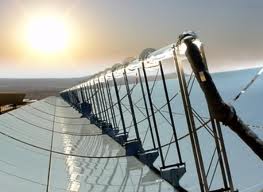The first detailed report into the potential of solar thermal energy in Australia is expected to predict that the technology could account for half of Australia’s energy needs by 2050, but it needs support mechanisms to overcome short-term cost barriers.
RenewEconomy understands that the report, to be released tomorrow, “Realising the potential of Concentrating Solar Power in Australia”, suggests that 15GW of solar thermal and concentrating solar PV technology could be deployed in the near-to-medium term, accounting for up to 30 per cent of the country’s total generation capacity. However, its longer term potential is even greater.
But the report will say that the technology faces many barriers. This includes connecting the best solar resources with the grid, and on providing a roadmap that brings the costs of solar thermal technologies down from around 250/Mwh to $120-$130/MWh – where its ability to provide dispatchable power, particularly in peak times, means that it can compete with fossil fuels.
The CSP industry finds itself in a similar position to solar PV a decade ago – with a promising technology, but a need to find incentives to bring the cost down. As the experience with solar PV has shown, that will mostly happen through deployment, and the cost cuts that have and are being achieved by solar PV continue to defy expectations.
However, the biggest fear for CSP is that is will get shunted aside by competing technologies such as solar PV – this has already happened in some large-scale projects in the US and Spain, where the deployment of solar thermal has been the most active.
In Australia, only a handful of pilot plants have been built, while two other demonstration facilities are in the process of construction. Australia’s largest solar thermal project, the 250MW $1.2 billion Solar Dawn installation in Queensland, remains under a cloud as it seeks to secure a power purchase agreement and finance for construction. Several environmental and renewable energy groups have been lobbying for a large-scale solar thermal plant to replace the ageing and highly polluting Playford brown coal plants in Port Augusta in South Australia.
The report, prepared by consultancy IT Power on behalf of the Australian Solar Institute, will note that as only a few countries are investing in solar thermal, Australia has an opportunity to claim a significant place in the global clean energy supply chain, particularly given its excellent R&D in the sector. But it will warn that any delay in that action could see the opportunity missed.
Indeed, while Australia’s Solar Flagships program is stalled by financing problems, a similar sized facility built by the same people as Solar Dawn – the French energy giant Areva, using Australian compact linear Fresnel reflector technology – is about to begin construction in India, where a national program aims to install 22GW of solar power by 2022. In South Africa, three separate projects totaling 200MW have been mandated under that country’s renewable energy program, and are expected to begin construction within the next 12 months. Other solar thermal projects are being contemplated in north Africa and the Middle East.










